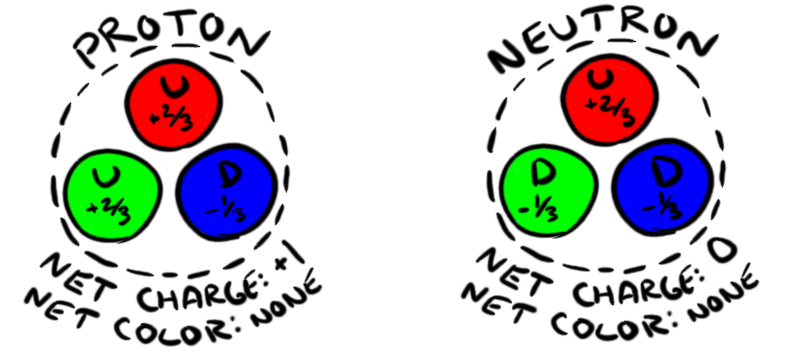 Three Quarks for Hadron Mark
Three Quarks for Hadron Mark
All the matter that is around you is made up of atoms. That's a pretty well-known fact at this point, and, while it gets increasingly interesting and strange the more you think about it (the properties of each different element are just functions of how many protons it has, which is pretty wild), an atom is not the fundamental unit of matter, as its name, derived from the Greek atomos, which means indivisible, would suggest. No, the physicist John Dalton disabused us of that notion back in the 1800s, and since then we have learned that an atom consists of three constituent particle types: protons, neutrons, and electrons. Hans Geiger, Ernest Marsden, and Ernest Rutherford came up with the model of an atom with those pieces (as covered in the very first Fizzix Phriday blog post), and that most of the mass of an atom was concentrated at the center, or nucleus, where the protons, positively-charged particles, and neutrons, particles lacking any electric charge, lived. Tiny and far away from them are the orbiting electrons. For a while, it was believed that those three sub-atomic particles were the smallest possible building blocks of matter. It wasn't until the 1960's and Murray Gell-Mann and George Zweig that physicists discovered that some of these particles, namely the protons and neutrons, which are both members of a type of heavier particle known as a hadron, are made up of even smaller pieces.
While electrons are, as far as we know, fundamental particles which cannot be broken down into tinier pieces (electrons are part of a class of elementary particles called leptons), both protons and neutrons are composite particles. Specifically, they are baryons, which are a class of hadron that is made up of three elementary particles called quarks. So, what are quarks, exactly? And what holds them together? Well, I'm so glad you asked, because that's what I'm here to discuss.
First of all, what exactly are quarks? What are their properties? Well, since protons have an electric charge, the particles that make them up must also have an electric charge, to give the resulting particle charge. And they do! Quarks have an electric charge to them. Since baryons like the proton are made up of three quarks, you can add the charges of three types of quarks together to get an electric charge of +1. But wait! Neutrons have no charge, and are also baryons! This is still fine, because you can add up the charges of three kinds of quarks, and get an electric charge of 0. How can this be? Well, what it means is there have to be different types of quarks, so that you can mix and match them in groups of three to get either +1 or 0, depending on your group. And indeed there are. There are six different kinds of quarks, which physicists call different flavors of quarks. This has nothing to do with actual taste, because they're way too small to have a taste, flavor is just some clever physicist's term for a variant. The six flavors of quarks are up, down, top, bottom, strange, and charm. Each flavor of quark has a different electric charge as well: up, top, and charm quarks have an electric charge of +2/3, and down, bottom, and strange quarks have an electric charge of -1/3.
From those charges, you can see that a proton could be constructed with two +2/3 charge and one -1/3 charge quarks (to get +1), and a neutron can be made from two -1/3 charge and one +2/3 charge quarks (to get 0). In fact, we know exactly what flavors make up a proton: two up quarks and a down quark. Neutrons are made of the opposite: two down quarks and an up quark. All the baryons in normal matter only use those two flavors of quark: up and down. These flavors are part of what is called the first generation of quarks. These quarks are the lightest of quarks, and don't have any other weird properties to them. They are the basic, boring, vanilla quarks, and they make up the basic, boring, vanilla matter that you see around you.

Pictured: Boring, vanilla matter
The second generation of quarks is where it starts getting weirder. These are the strange and charm quarks. They have properties, known as charm and strangeness to them, from which they take their names. These are mysterious conserved quantities for some quantum interactions that make matter which has strange or charm quarks behave in a slightly different and unexpected way. Also, they have much larger masses, with the strange quark at about 19 times more massive than the down quark (the heaviest first generation quark), and the charm quark clocking in at 255 times as massive as the down quark.
The third generation of quarks is the final generation, which includes the top and bottom quark flavors. These quarks, much like the strange and charm in the second generation, have conserved quantum quantities called topness and bottomness from which they derive their name (or those quantities' names are derived from the quark's flavors). Like strangeness and charm, these quantities affect quantum interactions (they are conserved in strong and electromagnetic interactions, but not weak interactions), and make behavior of hadrons with top or bottom quarks in them behave differently than our plain vanilla matter composed of first generation quarks. And, akin to how the second generation of quarks was much more massive than the first, so too is the third generation much more massive than the second. The bottom quark is 836 times more massive than the down quark, or almost three and a half times as massive as the heaviest second generation quark, the charm quark. And the top quark. Oh, man, the top quark. It's about 36,000 times more massive than the down quark, or 136 times as massive as the charm quark. Incredibly, that's almost as big as the mass of an entire gold atom. Needless to say, we don't see third generation quarks very often.
But what exactly holds these quarks together in hadrons? If our baryons are made of three quarks, then it can't be the electromagnetic force, because we have two quarks with alike charges and only one with an opposite charge. While the opposite one will be attracted to the other two, those two will want to repel from each other. It hearkens back to the basic rule of electromagnetism: opposite charges attract, like charges repel. So there must be some other force holding them together. That force is called the strong nuclear force, and it makes the electromagnetic force (and the weak nuclear force, which holds together nucleons in the atomic nucleus) look trivial by comparison. And this force, much like the electromagnetic force, has some charge-like quantity that governs what is attracted to what. In quarks, that quantity is know as color, or color charge.
Obviously, this is not an actual color. Color can only emerge on bigger scales, and it's just another clever name. But color charge is trickier than electric charge, because it's not a simple positive or negative. Instead, quarks can have one of three different colors: red, green, or blue. These colors obey the same basic principle as electromagnetic charge, though: like colors repel, unalike colors attract. What this means is that, say, a red quark will be attracted (via the strong nuclear force) to blue and green quarks, but repelled from other red quarks. In fact, every hadron has to be made up of what is called a colorless combination of quarks. In the case of baryons, this is a red, green, and blue. In light, combining the colors red, green, and blue (the primary colors) results in white, or colorless light, so combining quarks in this color combination is considered a colorless combination.

Boring, vanilla matter—Now in technicolor!
Now I mentioned earlier that hadrons are composite sub-atomic particles made up of quarks, and that baryons are a type of hadron that is composed of three quarks. So, the question follows: are there other types of hadrons that are made up of different numbers of quarks? Yes, there are. The other category of hadron is a class of sub-atomic particles called mesons, which are made up of only two quarks. You may have already spotted the problem there: if every hadron has to be made up of colorless combinations of quarks, how can you combine only two quarks to be colorless? The answer is antimatter. Antiquarks are also quarks, but with reversed quantum numbers (like how an anti-electron, called a positron, is the same mass as an electron (and is also a lepton), but has an opposite charge, +1, as opposed to an electron's -1). So, an antiquark, in addition to having a reverse electric charge, also has a reverse color charge. That means that the three colors an antiquark can take are antired, antigreen, and antiblue. Yes, those are the names. I'm sorry.
Since an anticolor of an antiquark is precisely the opposite, or negation, of its non-anticolor (oh man that's weird phrasing), it cancels out with it and the resulting quark-antiquark pair is also colorless. That means that a meson is always composed of one quark and one antiquark, with the antiquark having the anticolor of the quark (say, a red quark and an antired antiquark). There is also the (likely) possibility of what are called "pentaquarks," which are a particle composed of five quarks, three quarks which are colorless by combination of red, green, and blue colorings, and one quark and one antiquark whose colors cancel each other out as well. Color is a kind of tricky concept with quarks, but it does still boil down to "like repel, unalike attract." Red and antired are unalike, so they attract. Red and blue are unalike, so they attract. Red and red are like, so they repel. It's like electromagnetism, except so much more complicated.
So before I said that all hadrons had to be colorless. What I really should have said is that all quark combinations must be colorless. And that's not just an arbitrary rule that physicists have made up, its a fundamental tenet of the universe. Except at extraordinarily high energy levels, like those right after the Big Bang, quarks cannot exist on their own. And the way that ends up working is super weird.
Let's say that you have a random hadron. For simplicity, we'll make it a neutron, which is composed of two down quarks and one up quark. Let's say you somehow get some sub-atomic tweezers and grab ahold of that pesky up quark. You put the rest of the hadron in a vice (this is super impossible to do, by the way, but the actual way it's done is really, really complicated, so we're sticking with a more understandable scenario), so that the two down quarks can't move. Now, you begin to pull on the up quark. Somehow, you're strong enough to begin pulling it away from the down quarks, even though the strong force is 137 times stronger than the electromagnetic force. What you'll find is that it's like stretching a rubber band—the further away you get the up quark, the harder it is to keep pulling, and you have to put more energy in. Eventually, that "rubber band" snaps, and all the energy from it goes into creating a quark and antiquark pair, the quark joining up with the two down quarks you were just pulling the up away from, keeping it a baryon, and colorless, and the antiquark joining up with the up quark you were pulling away, making it a meson, and still colorless. You physically cannot separate quarks into colorful combinations, because the energy you use trying to separate them just goes into making new quarks. If your up quark was red, when the two new quarks appeared, they would be a red and antired quark, and the neutron would still have a combination of red, green, and blue, and your new meson would be colorless by virtual of a red-antired pair. Unless you make the space around where you're doing this hot, and I mean initial-conditions-of-the-universe hot, there just isn't a way to get a quark on its own. The strong force just doesn't let you.
And that's a quick overview of quarks! They're really neat, really tiny particles that make up other really tiny particles. They have a weird new feature called color that only exists at that level, and has its own associated force that's stronger than everything else, and doesn't let quarks exist by their lonesome. They also come in flavors with increasingly funny names. There's a lot of fascinating stuff happening in the sub-atomic world, even though we can't see it. Everything around us is made up of ridiculously small parts, which themselves are often made up of smaller parts, which themselves have crazy properties and strange interactions—but they combine to make up everything we see. The more you think about it, the stranger it all seems, and that's good! The universe is a crazy, cool, and very strange place, and it's always fun and illuminating to investigate it.
Oh! And I almost forgot to explain the title, which probably seems like a pretty weird statement. Obviously, three quarks form a baryon, and baryons are a kind of hadron, so it's not too out of left field, but it's actually an altered line of a poem, from which the name "quark" was taken. Gell-Mann, who named these sub-atomic particles, took the name from the book Finnegans Wake, by James Joyce. The unaltered lines read:
--Three quarks for Muster Mark!~ James Joyce, Finnegans Wake
Sure he hasn't got much of a bark
And sure any he has it's all beside the mark.
Finnegans Wake also has a reputation of being strange and difficult to understand, so maybe quarks, with all their weird properties and craziness, have found a name that is quite fitting. Or maybe the "quarks" in Finnegans Wake was supposed to refer to "quarts," and be pronounced to rhyme with "mark," and Gell-Mann just liked the way the work looked and altered its pronunciation to rhyme with "fork." The world may never know (we do, it's the second one).
